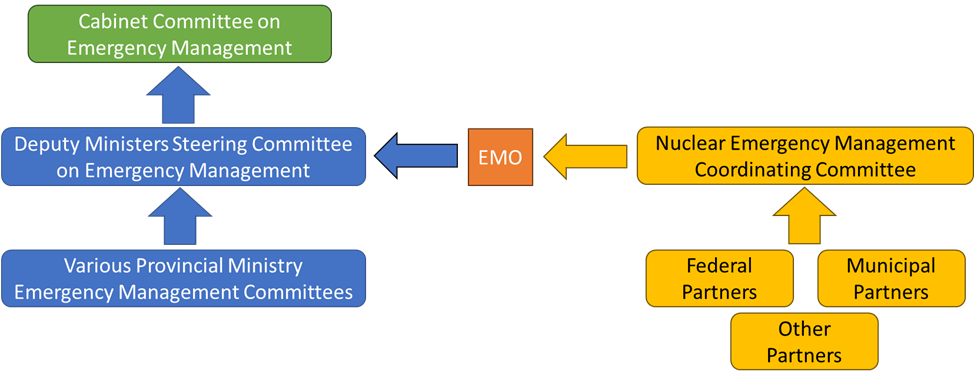Chapter 4 Governance
4.1 General
The Policy (Section 2) prescribes provincial senior management’s commitment to the program; detailing roles and responsibilities and assigning accountability and authority to participants of the program (see Figure 2 ).
4.1.1 PNERP Oversight
Oversight of the PNERP is the responsibility of the Minister of Emergency Preparedness and Response, who directs the actions of the Commissioner of Emergency Management (CEM). A detailed explanation of the enabling authority, roles, and responsibilities for maintaining the PNERP is detailed in Section 2.
4.1.2 PNERP Support
It is expected that provincial senior management will support the PNERP in all aspects by:
- Promoting the requirements of the PNERP within their organizations.
- Accepting management roles with PNERP oversight responsibilities within their organizations.
4.1.3 Administration
The approval authority for the PNERP is the Lieutenant Governor in Council. The Minister responsible for emergency management with the support of the CEM, and EMO, leads the development, implementation, evaluation, maintenance, and continual improvement of the PNERP.
4.1.4 Resource Allocation
Senior management of ministries with PNERP responsibilities shall ensure that their ministry has the resources to develop, implement, evaluate, and meet their responsibilities as identified within the PNERP. If those responsibilities cannot be met (e.g., lack of personnel, insufficient resources, lack of training, etc.) senior managers shall report their deficiencies to their superiors for resolution. If the deficiencies persist, the CEM shall be notified for discussion/resolution as needed with the appropriate Deputy Minister.
4.1.5 Program Coordination
Each ministry shall appoint at least one primary and at least one alternate point of contact to coordinate PNERP actions with other ministries. As the lead organization EMO may have more than one point of contact to coordinate and track its PNERP related actions with other ministries.
4.1.6 PNERP Review Committee
4.1.6.1 Establishment
Ministries which have a role as identified in the PNERP shall establish a ministerial review committee and conduct bi-annual meetings to assess the state of their emergency preparedness (see Figure 3 ). Part of that meeting shall address their responsibilities within the PNERP specifically. Minutes of those meetings shall be shared with the CEM, with outstanding issues and proposed solutions to be reported to the CEM for resolution.
In addition to the DMSC-EM, a NEMCC shall be established. The NEMCC will be comprised of key federal, provincial, and municipal representatives, as well as other invited organizations (e.g., First Nation and Indigenous communities, United States member states, and CNSC licensed facilities). The PNERP review committee includes the NEMCC and others who have the required expertise, knowledge of the organization, and the capability to identify resources from all key functional areas within the organization. Various committees as shown in Figure 3 have a role in reviewing the PNERP.
This diagram is for visual reference only. See the text below this figure for the full description.
Figure 3 : Committee Relationships
The diagram illustrates the committee relationships within Ontario’s nuclear emergency management structure. At the top is the Cabinet Committee on Emergency Management, followed by the Deputy Ministers Steering Committee on Emergency Management, and ending with the Various Provincial Ministry Emergency Management Committees. Emergency Management Ontario is positioned alongside this structure and connects to the Nuclear Emergency Management Coordinating Committee, which includes Federal Partners, Municipal Partners, and Other Partners. Arrows indicate the relationships among these committees.
4.1.6.2 Strategic Input
NEMCC, sub-committees and working groups should provide strategic input and direction to their organizations to ensure the coordination, development, implementation, evaluation, maintenance, and continual improvement of the PNERP. Minutes shall be maintained for each meeting.
